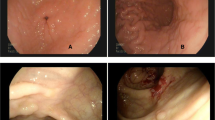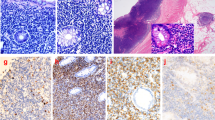Abstract
Enteropathy-associated T-cell lymphoma (ETCL) is a primary extranodal T-cell lymphoma arising in the gastrointestinal tract, and is known as a rare and highly aggressive disease with a poor prognosis. The diagnosis of ETCL is usually established by histological examination using resected tumors or biopsy specimens during endoscopic studies. If tumor specimens for histopathological investigation are not available, then such a case might be difficult to accurately diagnose. We report here a case of ETCL which was diagnosed by cytopathology and flow cytometric immunophenotyping using paracentesis fluid without tumor specimens. Immunophenotyping by flow cytometry (FCM) of the ascitic fluid (AF) was invaluable in the final diagnosis of ETCL. Moreover, genetic alterations in the current case were also demonstrated. We emphasize the usefulness of effusion cytology for the expeditious diagnosis of ETCL. In particular, even in cases without tumor specimens, immunophenotyping by FCM using AF can play an important role in the diagnosis of ETCL, and simultaneous genome analysis may be useful to elucidate the biological characteristics of ETCL.





Similar content being viewed by others
References
Lymphoma Study Group of Japanese Pathologists (2000) The World Health Organization classification of malignant lymphomas in Japan: incidence of recently recognized entities. Pathol Int 50:696–702
Chott A, Dragosics B, Radaszkiewicz T (1992) Peripheral T-cell lymphomas of the intestine. Am J Pathol 141:1361–1371
Isaacson PG (1999) Gastrointestinal lymphoma of T- and B-cell types. Mod Pathol 12:151–158
Kohno S, Ohshima K, Yoneda S et al (2003) Clinicopathological analysis of 143 primary malignant lymphomas in the small and large intestines based on the new WHO classification. Histopathology 43:135–143
Zettl A, Deleeuw R, Haralambieva E et al (2007) Enteropathy-type T-cell lymphoma. Am J Clin Pathol 127:701–706
Spencer J, Cerf-Bensussan N, Jarry A et al (1988) Enteropathy-associated T cell lymphoma (malignant histiocytosis of the intestine) is recognized by a monoclonal antibody (HML-1) that defines a membrane molecule on human mucosal lymphocytes. Am J Pathol 132:1–5
Isaacson PG (1994) Gastrointestinal lymphoma. Hum Pathol 25:1020–1029
Chott A, Haedicke W, Mosberger I et al (1998) Most CD56+ intestinal lymphomas are CD8+ CD5− T-cell lymphomas of monomorphic small to medium size histology. Am J Pathol 153:1483–1490
Cellier C, Delabesse E, Helmer C et al (2000) Refractory sprue, coeliac disease, and enteropathy-associated T-cell lymphoma. Lancet 356:203–208
Daum S, Weiss D, Hummel M et al (2001) Frequency of clonal intraepithelial T lymphocyte proliferations in enteropathy-type intestinal T cell lymphoma, coeliac disease, and refractory sprue. Gut 49:804–812
Das DK, Gupta SK, Ayyagari S et al (1987) Pleural effusion in Non-Hodgkin’s lymphoma. A cytomorphologic, cytochemical and immunologic study. Acta Cytol 31:119–124
Das DK (2006) Serous effusions in malignant lymphomas: a review. Diagn Cytopathol 34:335–347
Mihaescu A, Gebhard S, Chaubert P et al (2002) Application of molecular genetics to the diagnosis of lymphoid-rich effusions: Study of 95 cases with concomitant immunophenotyping. Diagn Cytopathol 27:90–95
Lundqvist C, Baranov V, Hammarström S et al (1995) Intra-epithelial lymphocytes. Evidence for regional specialization and extrathymic T cell maturation in the human gut epithelium. Int Immunol 7:1473–1487
Gorfu G, Rivera-Nieves J, Ley K (2009) Role of β7 integrins in intestinal lymphocyte homing and retention. Curr Mol Med 9:836–850
Deleeuw RJ, Zettl A, Klinker E et al (2007) Whole-genome analysis and HLA genotyping of enteropathy-type T-cell lymphoma reveals 2 distinct lymphoma subtypes. Gastroenterology 132:1902–1911
Conflict of interest
None.
Author information
Authors and Affiliations
Corresponding author
About this article
Cite this article
Nishimura, M., Tomo, K. A case of enteropathy-associated T-cell lymphoma: diagnosis by flow cytometric immunophenotyping and genome analysis using ascitic fluid. Int J Clin Oncol 16, 778–782 (2011). https://doi.org/10.1007/s10147-011-0252-0
Received:
Accepted:
Published:
Issue Date:
DOI: https://doi.org/10.1007/s10147-011-0252-0




